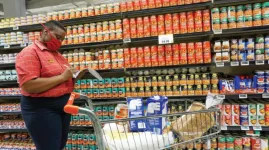Zimbabwe's Basic Food Costs Rise 6% in January.
The Zimbabwe National Statistics Agency reports that the cost of basic food in January 2025 jumped to ZiG861.14 per person, up from ZiG805.95 in December.
This amount, known as the Food Datum Line (FDL), represents the money needed for one person to consume 2,100 calories daily. The Total Consumption Poverty Line (TCPL), which measures the income needed to stay above poverty, increased to ZiG1,255.78 from ZiG1,156.67.
"The minimum needs basket cost ZiG861.14 per person in January," Zimstat stated. "An individual required ZiG1,255.78 to buy both food and non-food items without being considered poor."
Monthly inflation in the local ZiG currency climbed to 10.5% in January from 3.7% in December. The US dollar price index showed an 11.5% increase, up from 0.6% the previous month.
Zimbabwe uses both US dollars and the local ZiG currency, with most transactions happening in foreign currency. This stems from the large informal sector in the economy.
Experts point to recent government actions against illegal imports as a factor in rising US dollar prices. The crackdown reduced the supply of cheaper smuggled goods, pushing up demand and prices for legal imports. These items face additional costs from import duties, which sellers pass on to customers.
Economic analyst Wendy Mpofu cited inflation, supply problems, and new policies as key reasons for the FDL increase.
"Zimbabwe has seen high inflation rates in recent months, raising living costs and food prices. The higher FDL reflects these price increases," Mpofu explained.
The data reveals growing pressure on Zimbabwean households as basic needs become more expensive, affecting both local and US dollar purchases.
The Zimbabwe National Statistics Agency reports that the cost of basic food in January 2025 jumped to ZiG861.14 per person, up from ZiG805.95 in December.
This amount, known as the Food Datum Line (FDL), represents the money needed for one person to consume 2,100 calories daily. The Total Consumption Poverty Line (TCPL), which measures the income needed to stay above poverty, increased to ZiG1,255.78 from ZiG1,156.67.
"The minimum needs basket cost ZiG861.14 per person in January," Zimstat stated. "An individual required ZiG1,255.78 to buy both food and non-food items without being considered poor."
Monthly inflation in the local ZiG currency climbed to 10.5% in January from 3.7% in December. The US dollar price index showed an 11.5% increase, up from 0.6% the previous month.
Zimbabwe uses both US dollars and the local ZiG currency, with most transactions happening in foreign currency. This stems from the large informal sector in the economy.
Experts point to recent government actions against illegal imports as a factor in rising US dollar prices. The crackdown reduced the supply of cheaper smuggled goods, pushing up demand and prices for legal imports. These items face additional costs from import duties, which sellers pass on to customers.
Economic analyst Wendy Mpofu cited inflation, supply problems, and new policies as key reasons for the FDL increase.
"Zimbabwe has seen high inflation rates in recent months, raising living costs and food prices. The higher FDL reflects these price increases," Mpofu explained.
The data reveals growing pressure on Zimbabwean households as basic needs become more expensive, affecting both local and US dollar purchases.












